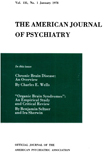Five Cases of Pigmentary Retinopathy Associated with Thioridazine Administration
Abstract
Out of a population of about 2,200 patients at Boston State Hospital in September and October of 1963, 164 patients were being treated with thioridazine. As a result of ophthalmological examination, five cases of pigmentary retinopathy were discovered in a group of eight patients who were receiving dosages of more than 1800 mg. of thioridazine and no changes were observed in those patients who received less.
The five patients all presented marked chronic mental disturbances such as one is unlikely to encounter in the community. Possibly because of their confusion and disorientation, they were unable to report any subjective symptoms which they may have been experiencing, such as brownished coloration of vision and diminution of night vision. The five patients who exhibited retinal changes had been treated with thioridazine for 15 days, one month, six months, six months, and ten months respectively. All five patients had received large doses of other medications prior to the administration of thioridazine, and the possibility of cumulative or additive effects has not been ruled out.
Access content
To read the fulltext, please use one of the options below to sign in or purchase access.- Personal login
- Institutional Login
- Sign in via OpenAthens
- Register for access
-
Please login/register if you wish to pair your device and check access availability.
Not a subscriber?
PsychiatryOnline subscription options offer access to the DSM-5 library, books, journals, CME, and patient resources. This all-in-one virtual library provides psychiatrists and mental health professionals with key resources for diagnosis, treatment, research, and professional development.
Need more help? PsychiatryOnline Customer Service may be reached by emailing [email protected] or by calling 800-368-5777 (in the U.S.) or 703-907-7322 (outside the U.S.).



